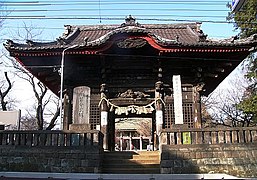Sen'yō-ji
The Sen'yō-ji ( Japanese 千葉 寺 ), also read Chiba-dera , with the mountain name Kaijō-san ( 海上 山 ), is a temple of the Shingon direction of Buddhism in the city of Chiba , Japan. In the traditional count it is the 29th of the 33 temples in the Kantō region .
history
According to tradition, the temple is said to have been founded in the 2nd year of Wadō ( 和 銅 ), i.e. 709. It is one of the oldest temples in the area. This is confirmed by excavations of old roof tiles ( 軒 丸 瓦 Nokimaru-gawara ), which date from the middle of the 8th century. Sutras ( 経 筒 Kyōzutsu ) and small vessels made of blue-and-white porcelain that were worn on the body ( 磁 合子Seihakuhi goshi ) were also found from the 12th century . These are registered as cultural objects of the prefecture.
In 1160, the temple grounds were struck by lightning and burned down completely. In 1192 Chiba Tsunetane ( 千葉 常 胤 ; 1118-1201), ruler in the area, was rebuilt by order of Minamoto Yoritomo , but no longer on an estimated 126 × 126 m, but on a smaller area. The Chiba continued to support the temple.
Until the Meiji period , the residents gathered on the evening of the last day of the year ( 大 晦 日 ōmisoka ) at the temple and expressed their dissatisfaction with the city administration, mixed with loose gossip. This often resulted in great laughter known as "Chiba laughter" ( 千葉 笑 い Chiba-warai ).
The temple complex was badly damaged during the air raids in the Pacific War .
The attachment
You enter the complex from the south through the temple gate with the curved roof section, which is designed as a Niō gate ( 仁王 門 Niō-mon ; 1 in the plan), i.e. as a gate with the two temple guards ( Niō ) to the right and left of the passage. On the way to the main hall, you will pass a tall ginkgo tree (G) on the right, which is estimated to be 1000 years old. He is referred to here as 大公 孫樹 (Ōichō), roughly "Great Prince and Grandson Tree". Further to the right behind it is the small Daishidō ( 大師 堂 ; 3), i.e. the hall that is dedicated to the temple founder.
The main hall ( 本 堂 Hondō ; 2) was destroyed in World War II. It has been rebuilt in a modern style based on the past. The abbot's quarters (A) with the administration ( 納 経 所 Nōkyōjo ) completes the complex, which includes a large cemetery (F).
On the temple grounds behind the main hall is the Ryūzō Shrine ( 瀧 蔵 神社 Ryūzō-jinja ; S).
Treasures of the temple
A copper lantern decorated with a plum and bamboo pattern ( 梅 竹 透 釣 灯 篭Umetake sukashitsuri tōrō ) has been excavated in front of today's temple gate . From the inscription on the umbrella we know that it dates back to 1550 and that it was donated by the Hara ( 原 氏 -shi ) family, a branch of the Chiba family. It is now located in the Tokyo National Museum , registered as an Important Cultural Asset .
photos
Remarks
- ↑ This roof section is called "Chinese gable" ( 唐 破 風 Karahafu ). It was modern after 1600.
- ↑ A modification of the usual spelling 大 イ チ ョ ウ / 大 銀杏 .
literature
- Chiba-ken kotogakko Kyoiku kenkyukai rekishi bukai (Ed.): Senyo-ji . In: Chiba-ken no rekishi sampo. Yamakawa Shuppan, 2006. ISBN 978-4-634-24612-6 . P. 8, 9.
Coordinates: 35 ° 35 ′ 42.5 ″ N , 140 ° 7 ′ 54.1 ″ E






